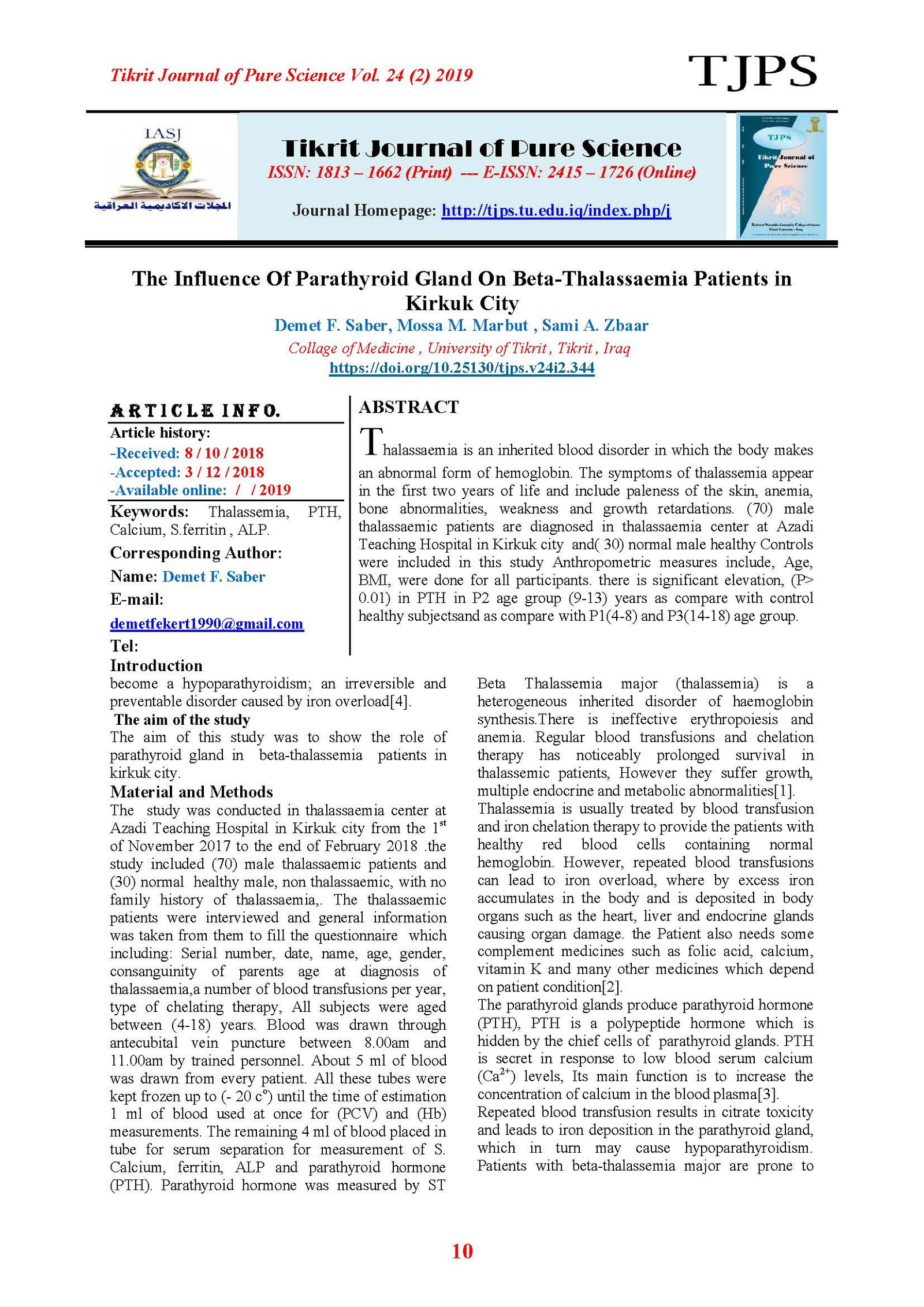The Influence Of Parathyroid Gland On Beta-Thalassaemia Patients in Kirkuk City
Main Article Content
Abstract
Thalassaemia is an inherited blood disorder in which the body makes an abnormal form of hemoglobin. The symptoms of thalassemia appear in the first two years of life and include paleness of the skin, anemia, bone abnormalities, weakness and growth retardations. (70) male thalassaemic patients are diagnosed in thalassaemia center at Azadi Teaching Hospital in Kirkuk city and( 30) normal male healthy Controls were included in this study Anthropometric measures include, Age, BMI, were done for all participants. there is significant elevation, (P> 0.01) in PTH in P2 age group (9-13) years as compare with control healthy subjectsand as compare with P1(4-8) and P3(14-18) age group
Article Details

This work is licensed under a Creative Commons Attribution 4.0 International License.
Tikrit Journal of Pure Science is licensed under the Creative Commons Attribution 4.0 International License, which allows users to copy, create extracts, abstracts, and new works from the article, alter and revise the article, and make commercial use of the article (including reuse and/or resale of the article by commercial entities), provided the user gives appropriate credit (with a link to the formal publication through the relevant DOI), provides a link to the license, indicates if changes were made, and the licensor is not represented as endorsing the use made of the work. The authors hold the copyright for their published work on the Tikrit J. Pure Sci. website, while Tikrit J. Pure Sci. is responsible for appreciate citation of their work, which is released under CC-BY-4.0, enabling the unrestricted use, distribution, and reproduction of an article in any medium, provided that the original work is properly cited.
References
[1] Basha, K.P.; Shetty, B. and Shenoy, U.V. (2014). Prevalence of Hypoparathyroidism (HPT) in Beta Thalassemia Major. Journal of Clinical and Diagnostic Research, 8 (2):24-26.
[2] Eman A. Askar.et al. (2013). Growth Parameters and Vitamin D status in Children with Thalassemia Major in Upper Egypt. I JHOSCR, 7(4):10-14.
[3] Hadi, H. et al. (2013). The dverse effects of thalassemia treatments including bloodtransfusion and main pharmacological therapies. J Pharm Sci, 8(4):199–204.
[4] Hamann, K.L. & Lane, N.E. (2006). Parathyroid hormone. Rheumatic Diseases Clinics of North America, 32: 703–719.
[5] Hamidieh, A.A. et al. (2009). Hypoparathroidism in patients with beta thalassemia major. IJHOSCR, 3:17-20.
[6] Khalafallah. H.;and Soliman, A.T, Ashour,R. (2009).Growth and factors affecting it in thalassemia major. Hemoglobin ,33(1):S116-S126.
[7] Mehta, Vikram. et al. (2010). Splenectomy In Management Of Thalassemia Major – A Boon For The Little Angel. The Internet Journal of Surgery, 24(1): 1-11.
[8] Prestcott E.et al. (2000). Hepatic iron concentration combined with long-term monitoring of serum ferritin to predict complications of iron overload in thalassaemia major. B J Haematol,110: 971-977.
[9] Pung-Amritt P. et al. (2001). Linear growth in homozygous beta-thalassemia and beta thalassemia hemoglobin E patients under different treatment regimens J Med Assoc Thai,84: 929-4.
[10] Phadke, S.R. and Agarwal, S.S. (2002). Growth faltering in non-compliant thalassemia major patients. Proceedings ISHG 2002 XXVII Annual Conference of Indian Socity of Human Genetics. “Recent Trends in Genomics”,89: 14-16.
[11] Palamidou, F. et al. (1998). Growth and management of short stature in thalassaemia major. J Pediatr Endocrinol Metab,11: 835-44.
[12] Skordis, N. and Kyriakou, A. (2011). The multifactorial origin of growth failure in thalassaemia. Pediatr Endocrinol Rev ,8(2):271-277.
[13] Soliman, A.T. et al.( 2015). Insulin-like growth factor and factors affecting it in thalassemia major. Indian J Endocrinol Metab ,19(2):251-245.
[14] Shapiro, R. and Heaney, R.P. (2003).Co-dependence of calcium and phosphorus for growth and bone development under conditions of varying deficiency. Bone ,32: 532-540.
[15] Gabriele, O. (1971). Hypoparathyroidism associated with thalassemia. South Med J, 64:115-6.
[16] Chern, J.P. and Lin, K.H. (2002). Hypoparathyroidism in transfusion dependent patients with B thalassemia. Pediatr Hematol Oncol ,24(4): 291-3.
[17] Zelly, D. R. et al. (2017). Vitamin D and Parathyroid Hormone Levels and Their Relation to Serum Ferritin Levels in Children with Thalassemia Major: One-Center Study in Western Indonesia. Journal of Advances in Medical and Pharmaceutical Sciences, 15(1): 1-5.
[18] Vichinsky. E. et al. (2007). Serum ferritin underestimates liver iron concentration in transfusion independent thalassemia patients ascompared to regularly transfused thalassemia and Sickle cellpatients. Pediatr Blood Cancer,49:329–332.
